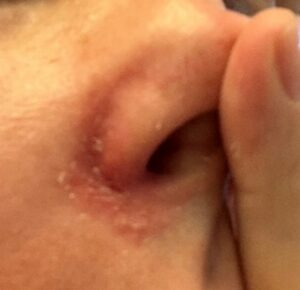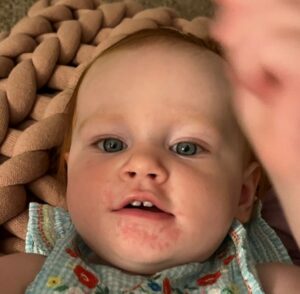Perioral dermatitis
Perioral Dermatitis
Recently we have been seeing a lot of a rash called “perioral dermatitis” or POD. We describe this as a dry or bumpy rash (small, inflamed dots) or a red, inflamed, scaly rash that occurs around the mouth, nose and/or eyes. POD often looks similar in appearance to facial acne, eczema or rosacea. This rash often stings or has a feeling like a windburn.
CAUSES
Sadly, we do not really know exactly what causes POD! This can be very frustrating as a parent! However, there have been a few irritants that have consistently been associated with the rash. These include:
- Topical corticosteroid use on the face. Commonly used topical steroids include hydrocortisone, triamcinolone, clobetasol, betamethasone, etc. Studies have shown that topical steroid use is FREQUENTLY reported in association with POD. The classic history we often hear as providers is a bumpy and slightly scaly facial eruption/rash that initially improves with topical corticosteroid use but recurs or worsens with continued use or attempts to discontinue corticosteroid therapy (a rebound inflammatory reaction). POD is often INCORRECTLY treated as “facial eczema” with steroids. The steroids initially help but then the rash returns and the rash duration is likely longer due to the steroid use. The reason for an association between POD and corticosteroids remains unclear. Some researchers have suggested that corticosteroid-induced damage to the epidermal (top layer of skin) barrier may be a contributing factor. What is the key message here? It is very important that steroids are almost never used on the face unless a patient is specifically directed to from their physician.
- Inhaled prescription steroid sprays used in the nose and mouth for asthma or allergy
- Overuse of heavy face creams and moisturizers
- Fluorinated toothpaste
- Candida (fungal) infection of the skin
- Demodex (mite) infection of the skin
DIAGONOSIS
To diagnosis the rash, our team at Holland Pediatrics will look at:
- The appearance of the skin and the rash
- History of the timeline of the rash and agents used on the face recently, recent infections, etc.
- What may have caused the rash
Sadly, a biopsy is not helpful. As the findings of skin biopsies vary based on the area biopsied and take on many of the characteristics of other skin conditions when evaluated under the microscope! The tissue biopsy does nothing to identify the cause either.
Below are some pictures of POD.



MANAGEMENT/TREATMENT
To treat the rash, it is very important to stop using ANY topical steroids and/or facial irritants (any skin care products and cosmetics that may irritate the skin). This is referred to as “zero therapy”. Be warned, the rash WILL WORSEN initially after steroids are discontinued – this is EXPECTED. During this time, one can use a gentle non-soap skin cleanser that is fragrance free followed by immediately rinsing the face with water to remove the cleanser. Once the rash has gone away for many weeks, one can re-introduce skin care products slowly (one product per week).
Studies have shown that the rash can typically be effectively treated with:
- Topical antibiotics
- Oral antibiotics
- Other topical anti-inflammatory medicine
**It is very important to note that this rash takes at least 8-12 weeks to treat. It is very UNLIKELY the rash would go away prior to at least 2 months of treatment. It is imperative that the patient continue to use the medication prescribed, even if he/she feels that it is not working. The medicine should also be continued several weeks after the rash is gone.
POD is a stubborn rash! But together with your team at HPA – we will get your child’s skin back to tip-top shape! If you think your child has this rash – please schedule an appointment today so we can properly examine your child and create a treatment plan that works for your child!

